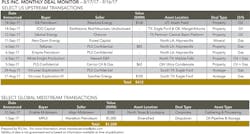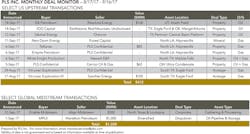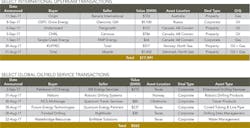Oil and gas deals slow to rebound as Gulf Coast recovers from Harvey
ANDREW DITTMAR, PLS INC. HOUSTON
LIKE VIRTUALLY EVERYTHING else heavily centered on Houston and the Texas Gulf Coast, US oil and gas deal flow has almost certainly been impacted by the tremendous damage caused by Hurricane Harvey. A Harvey-inflicted slowdown is entirely understandable given that many oil and gas professionals have been focused on restoring their or their family's personal lives while companies are still struggling with flooded offices or have put efforts primarily into getting existing operations back up and running. The next few months will tell whether this is a momentary pause in deals caused by the storm or a more lasting lull.
Already volatile oil prices have been made even more so by the very active Atlantic Hurricane season (Irma, Jose, and Maria in addition to Harvey as of press time) with conflicting views on the storms' effects on oil supply and fuel demand. This is in addition to an upcoming OPEC meeting and the unresolved question on whether the cartel will elect to extend current production cuts. With no clear picture one way or the other for oil, gas deals seem to be having an easier time finding their footing. This is especially true just inland from the Gulf Coast, where demand is expected to grow both locally for power generation along with major increases in petrochemical production and LNG exports.
The Haynesville stands out as the most popular of these plays with its proven productivity and favorable geographic location. A number of major private equity firms have already bought into the play since late 2016. Publicly-traded Tellurian Inc. (founded by ex-Cheniere CEO Charif Souki and Martin Houston) has now established a footprint in the North Louisiana portion of the Haynesville via an $85 million deal with a private equity-backed seller trimming its position. The company picked up current output of 4 MMcf/d along with 138 operated Haynesville/Bossier locations. Tellurian plans to use Haynesville gas as a feedstock for its proposed Driftwood LNG terminal. On the same day, another small public company, Empire Petroleum, announced it had signed a term sheet with a private seller to acquire Haynesville assets just to the north of where Tellurian's acreage will be.
Taking a slightly different tack on supplying Gulf Coast gas, proven STACK/SCOOP developer Vitruvian has launched its fourth iteration (and third partnership with PE-backer Quantum Energy Partners) by acquiring dry gas Eagle Ford acreage from Sanchez Energy. The company paid $105 million for Sanchez's 70,000-acre undeveloped Javelina asset in La Salle and Webb counties, Texas. Sanchez, along with the vast majority of Eagle Ford producers, is heavily focused on oil and liquids and was willing to part with this asset for $1,500/acre. Vitruvian was also able to pick up an additional 50,000 acres from private sellers and internal leasing efforts in the same area of the play. With core Haynesville trading at $8-10,000/acre, the less drilled dry gas Eagle Ford offers a potential higher risk/higher return profile for supplying gas to the Gulf Coast market.
Besides Gulf Coast gas, one of the biggest trends of 2017 has been Permian producers divesting their operations elsewhere. This has continued post-Harvey, including Carrizo Oil & Gas getting a $62 million-plus deal inked for its Utica condensate window leasehold in the immediate aftermath of the storm. Carrizo is also considering selling its DJ Basin and Marcellus positions to focus entirely on the Eagle Ford and Delaware Basin. Down the road, it would not be entirely surprising to see even the company's Eagle Ford position hit the market and Carrizo look to slim down to a Delaware Basin pure-play focused on its legacy assets there plus the substantial position acquired from ExL Petroleum earlier this year.
Resolute Energy is already far along in its transformation into a Delaware pure-play after agreeing to sell its Aneth oil field assets in Utah to Elk Petroleum for $160 million cash upfront plus a $35 million contingent payment based on oil prices. At press time, Halcón Resources is also close to wrapping up its transformation into an entirely Delaware Basin-focused producer. After emerging from bankruptcy, the company has been a prolific deal maker. Halcón established its footprint in the core Delaware via acquisitions from Samson Exploration and Sundown Energy while selling its El Halcón assets in the Eastern Eagle Ford and an operated Bakken portfolio for a combined total of over $2 billion. Now, the company is shedding its last non-Permian assets by divesting the remaining non-operated Bakken interests for a total of $110 million. Selling down non-Permian assets gives these companies much needed liquidity on the balance sheet for drilling while also potentially rewarding stock with the premium paid for Permian pure-plays.
Outside of the US, deal markets were very active during late summer. In one of the largest transactions anywhere this year, Total agreed to buy Maersk's E&P business for $7.5 billion. While its operations span the globe, Maersk has a particular concentration in the North Sea, including the Danish Underground Consortium and the Johan Sverdrup development. In an even larger deal, albeit one that smacks more of geopolitical posturing than oil and gas fundamentals, Glencore and the Qatar Investment Authority sold almost their entire equity stakes in Rosneft for $9.1 billion to CEFC China Energy. These interests had been acquired a mere nine months earlier, leading to an abundance of theories for the quick flip.


